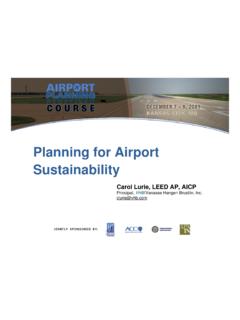Transcription of Evaluating Particulate Emissions from Jet Engines ...
1 The results of this study suggest that the range of size of particulateemissions from some jet Engines clusters below m and that theemissions contain heavy metals. Therefore, jet exhaust particulates (JEPs) have the potential to adversely affect both the environment andhuman health. Little is known about the Particulate component of jetengine Emissions . Baseline physical and chemical data on JEPs wereobtained to evaluate their potential effects on the environment. Parti-cles collected from the exhaust stream of two types of jet Engines wereexamined using scanning electron microscopy. Analysis indicated that100 percent of the particles collected were below m in size. Parti-cles in this size range can penetrate to the alveoli of human analyses of jet engine exhaust were conducted in an attemptto identify chemical fingerprints that would distinguish aviation emis-sions in the environment from other anthropogenic Emissions .
2 Certainheavy metals, especially vanadium, were found in jet exhaust and maybe useful chemical fingerprints. Analysis of JP-5 fuel standardsrevealed a suite of alkylbenzene hydrocarbons, which may also aid infingerprinting aviation Emissions . Sediment samples taken at coastalwetlands near airports indicated the presence of the same heavy metalsas those found in jet exhaust samples. Field sites exposed to higher vol-umes of air traffic contained higher levels of sediment heavy metals,supporting the hypothesis that aerial deposition of heavy metals isoccurring in areas near some aviation industry has committed substantial resources tostudying and reducing the adverse environmental impacts of itsactivities.
3 Most notably the problems of jet noise abatement andcontrol of airport runoff have been addressed. Increased attentionis being paid to jet engine Emissions as airlines continue toupgrade their fleets to achieve full Stage 3 compliance with the1990 Airport Noise and Capacity Act; concerns over Emissions arenot confined to noise, however. The latest challenge facing boththe aviation industry and its regulatory agencies is to address theair pollution generated by air traffic. Until recently commercial airtraffic had been mostly exempt from regulatory control of emis-sions. This is likely to change because the level of public concernabout environmental and health issues remains high and manyregions around the world are enacting more stringent air fuel consumption as a result of aviation is 180 milliontons annually (1).
4 Airlines operating out of the five commercial air-TRANSPORTATION RESEARCH RECORD 15171ports in the Los Angeles Basin produce 28 tons of Emissions of this amount comes from airplanes, the remainderfrom ground support equipment (2). Fuel consumption is expectedto increase. The International Civil Aviation Organization (ICAO)projects a 65 percent increase in aviation fuel consumption between1990 and 2010 (1). Because of the predicted increases, pressure forfurther regulation of aviation Emissions is also increasing. A recentmeeting of ICAO s Committee on Aviation Environmental Protec-tion resulted in a strong recommendation for increased stringency inthe regulation of both noise and Emissions from airports.
5 In theUnited States, the recently proposed federal implementation plan ofthe Clean Air Act in California suggested instituting a sliding scaleof reductions on aviation Emissions beginning in 2001 (3). The planproposed that airlines reduce Emissions in the Los Angeles Basin by35 to 45 percent by 2005 and that heavy fines, such as a fee of$10,000 per ton of excess Emissions , be levied against partiesexceeding the standards. The plan s standards applied to both air-planes and ground support equipment operated by the airlines. Theplan was not implemented because of a variety of economic andlogistic considerations, but it appears highly probable that regulationof airline Emissions will increase in the future.
6 It is vital that infor-mation on the effects of aircraft Emissions be collected so that futureefforts to reduce their impact can be as productive as in jet engine technology intended to reduce noise haveled to changes in emission profiles. New lower-noise Engines havereduced Emissions of hydrocarbons (HC) and carbon monoxide(CO) but have increased nitrous oxide (NOx) Emissions . Suchtradeoffs are often made when the reduction of specific emissioncomponents is pursued. Reductions in engine noise generallyrequire increased fuel burn, which also increases engine paradigm of tradeoffs in engine design makes it vital to collectdata on the relative environmental impacts of the chemical compo-nents of jet engine exhaust.
7 The data will allow priorities to be setfor the regulation of the most damaging Emissions and will helpguide the development of new engine technologies. For this study,information was collected on a relatively unstudied component ofjet engine exhaust Particulate operation of jet Engines results in the release of HC, CO,NOx, sulfur dioxide (SO2), and Particulate matter. Assessments ofthe impacts of engine Emissions and considerations of methods ofreduction have focused more on the pollutants CO, HC, and NOxEvaluating Particulate Emissions from Jet Engines : Analysis of Chemical and Physical Characteristics and PotentialImpacts on Coastal Environments andHuman HealthDepartment of Biology, University of California, Los Angeles, 405 HilgardAvenue, Los Angeles, Calif.
8 BOYLE because much more information is available on them. The 1994 EPA report Air Pollution Mitigation Measures for Airports andAssociated Activityomits Particulate matter from its discussion ofairport Emissions , stating, little is known quantitatively about jetengine Particulate Emissions (4). It is especially important toinvestigate the Particulate component of jet engine exhaust becausesome studies of air pollutants have found that particulates derivedfrom mobile sources have more serious adverse impacts on humanhealth than other anthropogenic Emissions such as ozone, nitrogen,and SO2(5).Internal combustion Engines are not the only sources of atmos-pheric particulates , but previous research indicates that they may beone of the most damaging.
9 A study comparing the toxicity tohumans of particulates from wood smoke and automobile exhaustfound that particles derived from the exhaust, a mobile source, had higher mutagenic potency than did particles from woodsmoke (6). Mobile source Emissions are estimated to compose thesingle largest source of health risk from airborne toxic pollutants (7). particulates in engine exhausts form because of incomplete com-bustion. Particulate Emissions are higher at low engine powersbecause combustion efficiency is lower. Particulate Emissions fromjet Engines are highest at takeoff and climbout, operations thatrequire very high fuel flow rates. Therefore, data would be expectedto show high Particulate Emissions around airports.
10 Aerial deposi-tion of exhaust particles from air traffic may have impacts on humanhealth and the environment. High levels of ambient Particulate mat-ter have been found to adversely affect human respiratory systems,causing the development of asthma, lung cancer, and chronic bron-chitis, among other problems (5,8,9). Particle size is an importantfactor in determining particulates toxicity to organisms. Particlessmaller than 10 m (PM10) are considered to be respirable. After aparticle is inhaled by an organism, size determines how far into thelungs it is likely to penetrate and can affect its chemical work has indicated that the fine fraction of PM10is oftenmore toxic than the coarse fraction (8).

